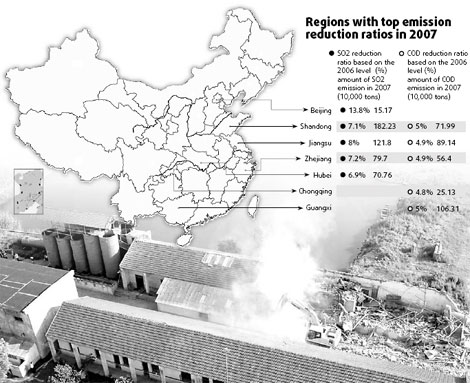


China has literally passed the halfway mark in a five-year marathon to clean up its environment, but the final results remain difficult to predict at the moment.
The country still has a long way to go if it is to achieve the target of cutting emissions by major pollutants by 10 percent between 2006 and 2010.
Although a "turning point" occurred in 2007, when the country saw a reduction in both chemical oxygen demand (COD) and the total emission of sulfur dioxide, the overall results of the first two years still fall behind expectations: the two indexes dropped only 2.14 and 3.16 percent respectively on the 2005 level, less than the supposed 4 percent.
But one thing is clear: the national environmental watchdog is constantly sharpening its teeth in a move to keep the pollution under control.
Last week, the Ministry of Environmental Protection (MEP) launched a fresh round of attacks on industrial polluters by dispatching 20 teams of 180 experts and officials to examine pollution reduction around the country.
A source from MEP says that total emissions control will be given the top priority in the substantial restructure of the ministry, which was announced in March.
The source, who asks not to be identified, tells China Business Weekly that revamping the MEP has won the go-ahead from the State Council, though final approval is yet to be issued.
The source says that according to the plan, the ministry will have three new departments covering environmental quality monitoring, emissions control as well as news and education. The move suggests an emphasis on the nationwide control of major pollutants based on more thorough research and the precise monitoring of results.
Last week, MEP released last year's results of provincial performances and five major power-generating groups' efforts at reducing COD, a measure of water pollution, and discharges of SO2, the main cause of acid rain.
Thanks to the enforcement of higher environmental standards and increased investment in green technologies, most provinces have fulfilled the promise to cut both pollutants by 2 percent, an annual target to ensure the 10 percent reduction by 2010. But there are still several cases that fail to reach the standard.
Yingtan in Jiangxi, Sanya in Hainan, Hechi in Guangxi and Yuxi in Yunnan have been criticized for poor wastewater treatment, and penalized by having approvals for new projects in the cities suspended.
Seven thermal power plants have also performed below par on SO2 emissions. The ministry will impose heavy fines on the power plants and urge them to improve their SO2 reducing technology.
Shandong province topped the SO2 emissions in the country by discharging more than 1.82 million tons in 2007, even though it has reduced 7.1 percent compared to 2006. Hu Tao, an expert on environmental protection policy, attributes it to an energy-intensive economy.
Hu says that coal-fired power generating takes up to 99 percent of the total electricity generated in the province, and that more than half of the country's thermal power plants are concentrated in Shandong. If the industrial structure cannot be adjusted, it will be difficult for the province to clear up its sky.
A similar dilemma faces Guangxi Zhuang autonomous region too, where the economy relies largely on heavy polluting industries such as paper-making and sugar-refining.
Although Guangxi topped the reduction ratio with 5 percent from 2006, it is still responsible for the 1.06 million tons of COD, the highest amount in the country.
According to a list published in February by National Development and Reform Commission, 1,391 small- and medium-sized papermaking firms in Guangxi will be closed due to their outdated production methods.
Wastewater from sugar refineries, which contains dissolved organics, also contributes to the high amount of COD in Guangxi, where over 50 percent of the country's sugar is produced.
Such a situation echoes the warning the State Council recently issued concerning the hurried growth of energy-consuming and polluting industries, which adds to the difficulties of MEP to curb pollution and realize its goals this year.
In a recent videoconference with national environmental staff, Zhang Lijun, vice-minister of MEP, called for extra efforts in the following months and said that the severe snowstorms that hit central and south China in the winter and the May earthquake that rocked southwestern China destroyed many pollution control and monitoring facilities.
(China Daily 07/14/2008 page4)













